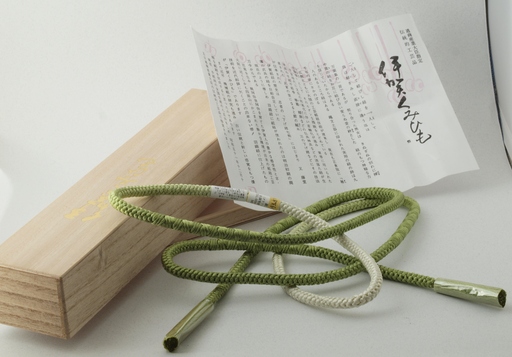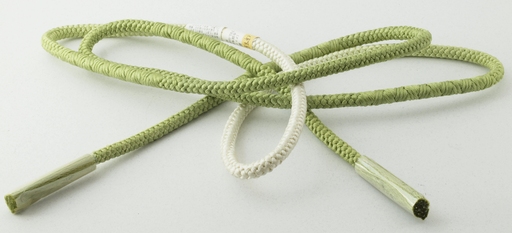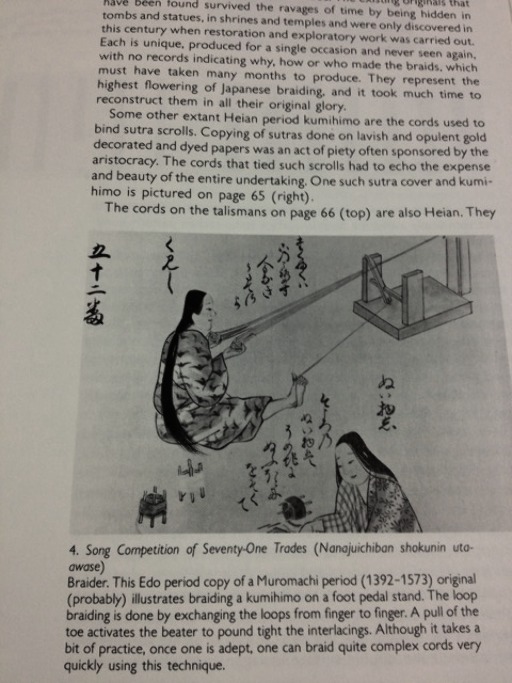This post is for f2tY's Japanese Father (Otousan). I know perhaps 20 words in Nihongo, and perhaps two or three kanji (most notably, the one for my own name: 森). f2tY's Otousan, however, has far more English, and struggles through my peripatetic writings, for which I feel deeply honored.
Anyway. The braid below is a souvenir, or omiyage, from f2tE, whose Okaasan kindly took hir to a kumihimo school.
Most of the braid is a simple tabby weave; and I'm guessing it is an 8 tama version of kara uchi gumi, with perhaps 12 ends (strands of silk per tama/bobbin). According to Martin's Kumihimo,
The word kara, meaning empty, refers to the hollow cylinder that is formed while making this braid. It will retain this shape if woven around a core...
It certainly has a core, because I was able to see it in the interstices of the weaving and with a 10x loupe I could see that the core was some sort of springy material, probably a synthetic, to give the braid resilience (i.e. resistance to kinking after being tied). f2tE told me it is silk, which is the traditional material (though Japanese also weave with a synthetic, called biron), and it is space dyed (i.e. after it was braided), with an ombre shift from the natural ivory color of the silk in the middle of the braid to a celery green towards the ends.
This would have been done by dipping the ends of the pre-wet braid in a vat of dye; the color would naturally crawl up, giving the graduated color shift.
As I understand it, cored braids are usually done on a kakudai (square stand) with the form (such a dowel) suspended from the ceiling but they can be made on marudai (round stand) as well. Sometimes with multiple ends of silk per tama, the braider is supposed to either keep the silk flat and smooth, or twist it while braiding (kind of like knitting through the front or back loop —the latter gives a twisted stitch, iirc).
I usually use single ends and one of the reasons why is because I'm too lazy to maintain the flat/twisted distinction—if my strands stay flat, great; if they twist, oh well.
This braid has occasional loose strands, gaps in the stitches, and irregularities in the amount of twist in the kara stitches—all of which surprised me a bit, but also made me very grateful. See, here's the thing: when I took traditional Japanese silk embroidery from Shay Pendray all those years ago, it was to be as perfect as we could make it; indeed the Japanese are famed for their attention to technique.
But looking at this braid, or sometimes old kimono embroidery, I can see little imperfections, because to the creator, the idea of the thing is more important than perfect technique. Obviously the maker is a skilled braider, because the tension of the stitches is even (and also, unlike all of my braids so far as I can recall) there are no mistakes—but ze's not hung up on these occasional slightly loose threads.
That's heartening.

The presentation—first rate, of course:) f2tE told me the braider was a ‘National Living Treasure’ which, if so, is presumably what that lovely insert documents. The paper, as many Japanese papers do, has a lovely, felty texture and visual interest the photo of course fails to convey.
I suspect this braid may be an obi tie of some sort...so speaking of Japanese braiding, I guess I ought to start embroidering again, to make myself an obi:)
Otousan sent me Exquisite: the world of Japanese Kumihimo braiding and though it has some very beautiful color photographs of braids, to me this was the most fascinating picture in the book, of a woman finger-loop braiding (kute-uchi). I still haven't made much progress, but I'm profoundly grateful that now at least I have the proper resources cued up.
Unless otherwise noted, text, image and objects depicted therein copyright 1996--present sylvus tarn.
Sylvus Tarn
